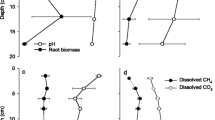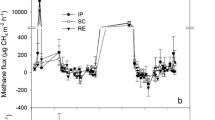Abstract
Wetlands are significant sources of the important greenhouse gas CH4. Here we explore the use of an experimental system developed for the determination of continuous fluxes of CO2 and CH4 in closed ecosystem monoliths including the capture of 14CO2 and 14CH4 following pulse labelling with 14CO2. We show that, in the ecosystem studied, ebullition (bubble emission) may account for 18 to 50% of the total CH4 emission, representing fluxes that have been difficult to estimate accurately in the past. Furthermore, using plant removal and 14C labelling techniques, we use the system to detail the direct influence of vascular plants on CH4 emission. This influence is observed to be dependent on the amount of vascular plants present. The results that may be produced using the presented experimental set-up have implications for an improved understanding of wetland ecosystem/atmosphere interactions, including possible feedback effects on climate change. In recent years much attention has been devoted to ascertaining and subsequently using the relationship between net ecosystem productivity and CH4 emission as a basis for extrapolation of fluxes across large areas. The experimental system presented may be used to study the complex relationship between vascular plants and CH4 emission and here we show examples of how this may vary considerably in nature between and even within ecosystems.
Similar content being viewed by others
References
Beckmann M. and Lloyd D. 2001. Mass spectrometric monitoring of gases (CO2, CH4, O2) in a mesotrophic peat core from Kopparås Mire, Sweden. Global Change Biol. 7: 171–180.
Billings W.D., Luken J.O., Mortensen D.A. and Peterson K.M. 1982. Arctic tundra: a source or sink for atmospheric carbon dioxide in a changing environment. Oecologia 53: 7–11.
Bubier J.L. and Moore T.R. 1994. An ecological perspective on methane emissions from northern wetlands. Trends Ecol. and Evol. 9: 460–464.
Bubier J.L., Moore T.R., Bellisario L. and Comer N.T. 1995. Ecological controls on methane emissions from a northern peatland complex in the zone of discontinuous permafrost, Manitoba, Canada. Global Biogeochem. Cycles 9: 455–470.
Cao M., Marshall S. and Gregson K. 1996. Global carbon exchange and methane emissions from natural wetlands: Application of a process-based model. J. Geophys. Res. 101D: 14399–14414.
Chanton J.P., Bauer J.E., Glaser P.A., Siegel D.I., Kelley C.A., Tyler S.C. et al. 1995. Radiocarbon evidence for the substrates supporting methane formation within northern Minnesota peatlands. Geochimica et Cosmochimica Acta 59: 3663–3668.
Christensen T.R. 1993. Methane emission from Arctic tundra. Biogeochem. 21: 117–139.
Christensen T.R. 1994. Exchange of radiatively active trace gases in tundra environments. PhD Dissertation, University of Cambridge, Cambridge.
Christensen T.R., Jonasson S., Callaghan T.V. and Havström M. 1995. Spatial variation in high latitude methane flux along a transect across Siberian and Eurasian tundra environments. J. Geophys. Res. 100D: 21,035–21,045.
Christensen T.R., Jonasson S., Callaghan T.V., Havström M. and Livens F.R. 1999. Carbon Cycling and Methane Exchange in Eurasian Tundra Ecosystems. Ambio 28: 239–244.
Christensen T.R., Friborg T., Sommerkorn M., Kaplan J., Illeris L., Soegaard H. et al. 2000. Trace gas exchange in a high-arctic valley, 1, Variations in CO2 and CH4 flux between tundra vegetation types. Global Biogeochem. Cycles 3: 701–714.
Christensen T.R., Prentice I.C., Kaplan J., Haxeltine A. and Sitch S. 1996. Methane flux from northern wetlands and tundra: an ecosystem source modelling approach. Tellus 48B: 651–660.
Crill P.M., Bartlett K.B., Harriss R.C., Gorham E., Verry E.S., Sebacher D.I. et al. 1988. Methane flux from Minnesota peatlands. Global Biogeochem. Cycles 2: 371–384.
Dannenberg S. and Conrad R. 1999. Effect of rice plants on methane production and rhizospheric metabolism in paddy soil. Biogeochem. 45: 53–71.
Daulat W.E. and Clymo R.S. et al. 1998. Effects of temperature and watertable on the efflux of methane from peatland surface cores. Atmospheric Environment 32: 32–3218.
Fan S.M., Wofsy S.C., Bakwin P.S., Jacob D.J., Anderson S.M., Kebabian P.L. et al. 1992. Micrometeorological Measurements of CH4 and CO2 Exchange Between the Atmosphere and Subarctic tundra. J. Geophys. Res. 97: 16627–16644.
Fowler D., Hargreaves U., Skiba R., Milne M.S., Zahniser M.S., Moncrieff J.B. et al. 1995. Measurements of CH4 and N2O fluxes at the landscape scale using micrometeorological methods. Phil. Trans. R. Soc. London A351: 339–356.
Frenzel P. and Rudolph J. 1998. Methane emission from a wetland plant: the role of CH4 oxidation in Eriophorum. Plant and Soil 202: 27–32.
Frenzel P. and Karofeld E. 2000. CH4 emission from a hollow-ridge complex in a raised bog: The role of CH4 production and oxidation. Biogeochem. 51: 91–112.
Friborg T., Christensen T.R. and Søgaard H. 1997. Rapid response of greenhouse gas emission to early spring thaw in a subarctic mire as shown by micrometeorological techniques. Geophys. Res. Let. 24: 3061–3066.
Friborg T., Christensen T.R., Hansen B.U., Nordstroem C. and Soegaard H. 2000. Trace gas exchange in a high-arctic valley, 2, Landscape CH4 fluxes measured and modeled using eddy correlation data. Global Biogeochem. Cycles 14: 715–724.
Gorham E. 1991. Northern peatlands: role in the carbon cycle and probable responses to climatic warming. Ecol. Appl. 1: 182–195.
Hein R., Crutzen P.J. and Heimann M. 1997. An inverse modelling approach to investigate the global atmospheric methane cycle. Global Biogeochem. Cycles 11: 43–76.
IPCC (Intergovernmental Panel on Climate Change) 1995. Climate Change 1994, Radiative Forcing of Climate Change and An Evaluation of the IPCC IS92 Emission Scenarios. Cambridge University Press, Cambridge.
Joabsson A., Christensen T.R. and Wallén B. 1999. Vascular plant controls on methane emissions from northern peatforming wetlands. Trends Ecol. and Evol. 14: 385–388.
Kelker D. and Chanton J. 1997. The effect of clipping on methane emissions from Carex. Biogeochem. 39: 37–44.
King J.Y., Reeburgh W.S. and Regli S.R. 1998. Methane emission and transport by arctic sedges in Alaska: Results of a vegetation removal experiment. J. Geophys. Res. 103: 29083–29092.
King J.Y. and Reeburgh W.S. 2002. A pulse-labeling experiment to determine the contribution of recent plant photosynthates to net methane emission in arctic wet sedge tundra. Soil Biology and Biochemistry 34: 173–180.
Malmer N. 1962. Studies on mire vegetation in the archaean area of southwestern Götaland (South Sweden). Opera Botanica 7: 1–322.
Megonigal J.P., Whalen S.C., Tissue D.T., Bovard B.D., Albert D.B. and Allen A.S. 1999. A plant-soilatmosphere microcosm for tracing radiocarbon from photosynthesis through methanogenesis. Soil Science Society of America Journal 63: 665–671.
Minoda T. and Kimura M. 1994. Contribution of photosynthesized carbon to the methane emitted from paddy fields. Geophys. Res. Let. 21: 2007–2010.
Minoda T., Kimura M. and Wada E. 1996. Photosynthates as dominant source of CH4 and CO2 in soil water and CH4 emitted to the atmosphere from paddy fields. J. Geophys. Res. 101: 21091–21097.
Nykänen H., Alm J., Lång K., Silvola J. and Martikainen P.J. 1995. Emission of CH4, N2O and CO2 from a virgin fen and a fen drained for grassland in Finland. J. Biogeography 22: 1149–1155.
Oechel W.C., Hastings S.T., Vourlitis G., Jenkins M., Riechers G. and Grulke N. 1993. Recent change of Arctic tundra ecosystems from a net carbon dioxide sink to a source. Nature 361: 520–523.
Oechel W.C., Vourlitis G.L., Hastings S.J., Zulueta R.C., Hinzman L. and Kane D. 2000. Acclimation of ecosystem CO2 exchange in the Alaskan Arctic in response to decadal climate warming. Nature 406: 978–980.
Panikov N.S. 1995. Microbial Growth Kinetics. Chapman & Hall, London.
Panikov N.S., Dedysh S.N., Kolesnikov O., Mardini A. and Sizova M.V. 2001. Metabolic and Environmental Control on Methane Emission from Soils: Mechanistic Studies of Mesotrophic fen in West Siberia. Water, Air, and Soil Pollution Focus 1: 415–428.
Reeburgh W.S., King J.Y., Regli S.K., Kling G.W., Auerbach N.A. and Walker D.A. 1998. A CH4 emission estimate for the Kuparuk River Basin, Alaska. J. Geophys. Res. 103: 29005–29013.
Roulet N.T., Jano A., Kelly C.A., Klinger L., Moore T.R., Protz R. et al. 1994. Role of the Hudson Bay lowland as a source of atmospheric methane. J. Geophys. Res. 99D: 1439–1454.
Saarinen T., Tolonen K. and Vasander H. 1992. Use of 14C labelling to measure below-ground biomass of mire plants. Suo 43: 245–247.
Schimel J.P. 1995. Plant transport and methane production as controls on methane flux from arctic wet meadow tundra. Biogeochem. 28: 183–200.
Sonesson M. (ed.) 1980. Ecology of a subarctic mire. Ecological Bulletins 30. Swedish Natural Science Research Council, Stockholm.
Thomas K.L., Benstead J., Davies K.L. and Lloyd D. 1996. Role of wetland plants in the diurnal control of CH4 and CO2 fluxes in peat. Soil Biol. and Biochem. 28: 17–23.
Tieszen L.L., Johnson D.A. and Caldwell M.M. 1974. A portable system for the measurement of photosynthesis using 14Carbon dioxide. Photosynthetica 8: 151–160.
Verville J.H., Hobbie S.E., Chapin F.S. III and Hooper D.U. 1998. Response of tundra CH4 and CO2 flux to manipulation of temperature and vegetation. Biogeochem 41: 215–235.
Waddington J.M., Roulet N.T. and Swanson R.V. 1996. Water table control of CH4 emission enhancement by vascular plants in boreal peatlands. J. Geophys. Res. 101: 22775–22785.
Wallén B. 1992. Methods for studying below-ground production in mire ecosystems. Suo 43: 155–162.
Walter B.P. and Heimann M. 2000. A process-based, climate-sensitive model to derive methane emissions from natural wetlands: Application to five wetland sites, sensitivity to model parameters, and climate. Global Biogeochem. Cycles 14: 745–766.
Whalen S.C. and Reeburgh W.S. 1992. Interannual variations in tundra methane emissions: A four-year time-series at fixed sites. Global Biogeochem. Cycles 6: 139–159.
Whiting G.J. and Chanton J.P. 1992. Plant-dependent CH4 emission in a subarctic Canadian fen. Global Biogeochem. Cycles 6: 225–231.
Whiting G.J. and Chanton J.P. 1993. Primary production control of methane emission from wetlands. Nature 364: 794–795.
Author information
Authors and Affiliations
Rights and permissions
About this article
Cite this article
Christensen, T.R., Panikov, N., Mastepanov, M. et al. Biotic controls on CO2 and CH4 exchange in wetlands – a closed environment study. Biogeochemistry 64, 337–354 (2003). https://doi.org/10.1023/A:1024913730848
Issue Date:
DOI: https://doi.org/10.1023/A:1024913730848




